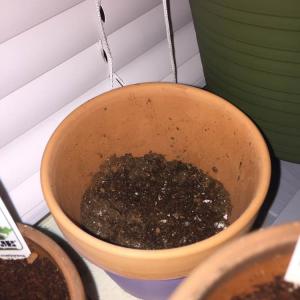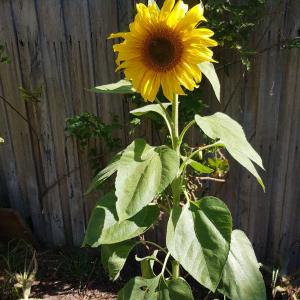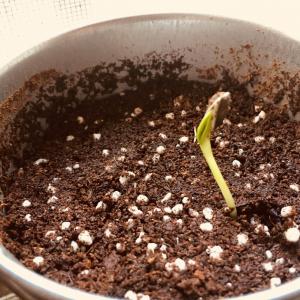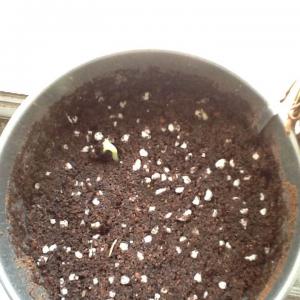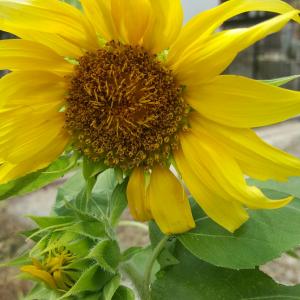文章
Dummer. ゛☀
2017年10月02日

Scientific Name
Helianthus annuus L.

Common Names
Sunflower, Grand Soleil (French), Tournesol (French), Sonnenblume (German), Girasole (Italian), Himawari (Japanese), Haebaragi (Korean), Girassol (Portuguese), Girasol (Spanish), Alizeti (Swahili), Solros (Swedish)
Synonyms
Helianthus annuus subsp. annuus, Helianthus annuus var. annuus, Helianthus annuus f. annuus, Helianthus aridus, Helianthus aridus var. aridus, Helianthus erythrocarpus, Helianthus indicus, Helianthus jaegeri, Helianthus lenticularis, Helianthus macrocarpus, Helianthus macrocarpus, Helianthus multiflorus, Helianthus ovatus, Helianthus platycephalus, Helianthus tubaeformis
Scientific Classification
Family: Asteraceae
Subfamily: Asteroideae
Tribe: Heliantheae
Genus: Helianthus

Flower
Color: Yellow and brown
Bloom Time: August to September
Description
Helianthus annuus is an annual herb, up to 10 feet (3 m) tall, with an erect, unbranched, rough-soft-hairy stem. The leaves are broad, coarsely toothed, rough and mostly alternate, up to 15 inches (40 cm) long. The flower is up to 15 inches (40 cm) in diameter and is actually a flower head of numerous small individual 5-petaled flowers (florets). The outer flowers which resemble petals are called ray flowers. The flowers in the center of the head are called disk flowers. The ray flowers are tongue-like and yellow in color, and the disk flowers are small, tubular and brownish. The fruit is long, flat-oval, slightly angular, smoothly haired–virtually glabrous cypsela, usually tipped with 2 withering bristles.
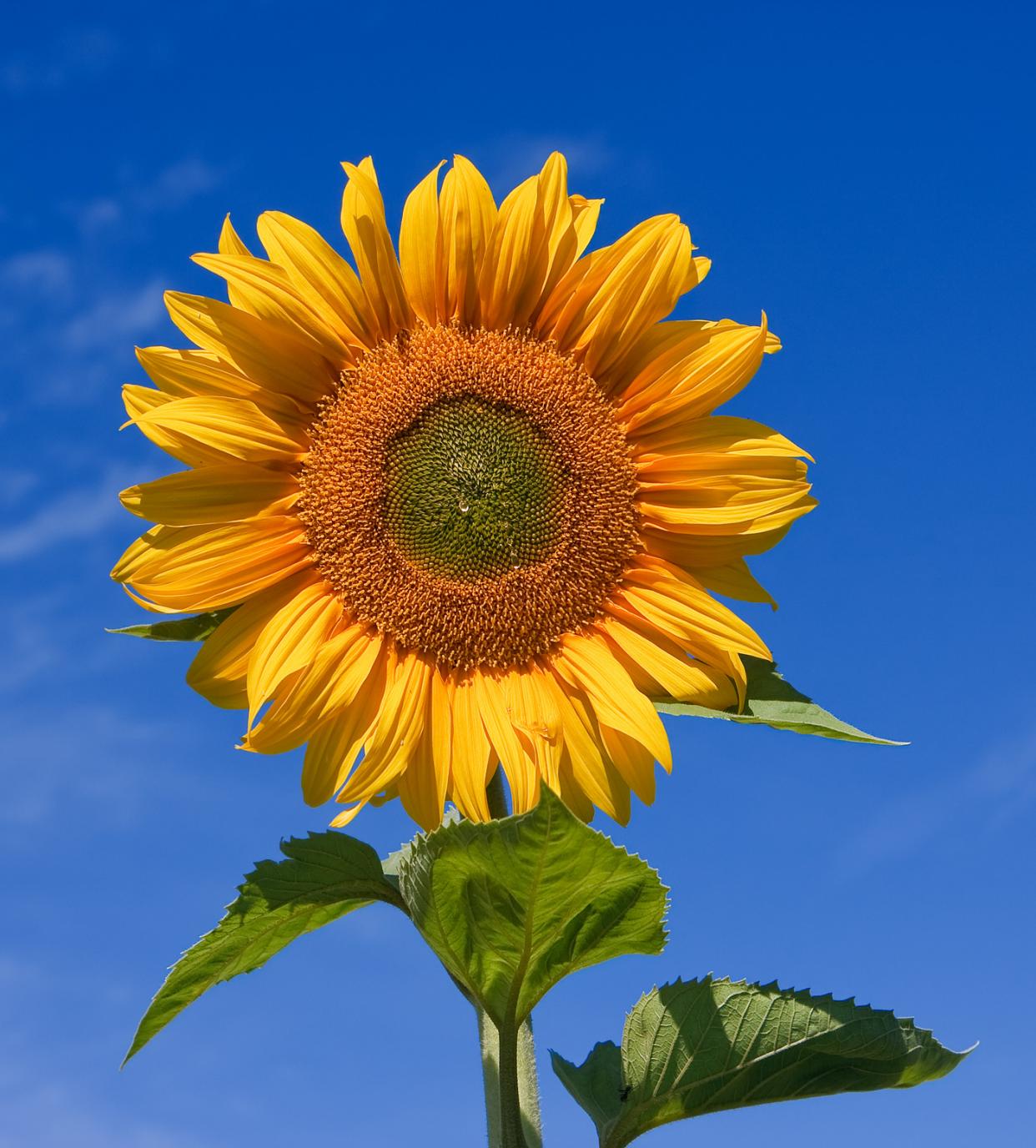
How to Grow and Care
If you decide to add Sunflowers to your garden, there are a few things you will want to keep in mind.
First of all, they are called sunflowers for a reason. They need sun. Make sure that the location you choose for your Sunflowers gets full sun.
Second, you do not need to worry about soil too much. They are not picky about the conditions of the soil, but they are plants. They will do better in better soil.
Third, Sunflower seed shells do contain a substance that is toxic to grass. So, you will need to either harvest the Sunflower heads before the seeds begin to fall out or you will need to plant your Sunflowers in a location where you do not mind any nearby grass being killed.
Fourth, keep in mind the height of the Sunflower variety you have chosen. A giant, twelve foot variety will end up acting very much like a small tree and may shade the surrounding flowers.
Origin
Native to the south-west of the United States, around the New Mexico area.
Helianthus annuus L.

Common Names
Sunflower, Grand Soleil (French), Tournesol (French), Sonnenblume (German), Girasole (Italian), Himawari (Japanese), Haebaragi (Korean), Girassol (Portuguese), Girasol (Spanish), Alizeti (Swahili), Solros (Swedish)
Synonyms
Helianthus annuus subsp. annuus, Helianthus annuus var. annuus, Helianthus annuus f. annuus, Helianthus aridus, Helianthus aridus var. aridus, Helianthus erythrocarpus, Helianthus indicus, Helianthus jaegeri, Helianthus lenticularis, Helianthus macrocarpus, Helianthus macrocarpus, Helianthus multiflorus, Helianthus ovatus, Helianthus platycephalus, Helianthus tubaeformis
Scientific Classification
Family: Asteraceae
Subfamily: Asteroideae
Tribe: Heliantheae
Genus: Helianthus

Flower
Color: Yellow and brown
Bloom Time: August to September
Description
Helianthus annuus is an annual herb, up to 10 feet (3 m) tall, with an erect, unbranched, rough-soft-hairy stem. The leaves are broad, coarsely toothed, rough and mostly alternate, up to 15 inches (40 cm) long. The flower is up to 15 inches (40 cm) in diameter and is actually a flower head of numerous small individual 5-petaled flowers (florets). The outer flowers which resemble petals are called ray flowers. The flowers in the center of the head are called disk flowers. The ray flowers are tongue-like and yellow in color, and the disk flowers are small, tubular and brownish. The fruit is long, flat-oval, slightly angular, smoothly haired–virtually glabrous cypsela, usually tipped with 2 withering bristles.

How to Grow and Care
If you decide to add Sunflowers to your garden, there are a few things you will want to keep in mind.
First of all, they are called sunflowers for a reason. They need sun. Make sure that the location you choose for your Sunflowers gets full sun.
Second, you do not need to worry about soil too much. They are not picky about the conditions of the soil, but they are plants. They will do better in better soil.
Third, Sunflower seed shells do contain a substance that is toxic to grass. So, you will need to either harvest the Sunflower heads before the seeds begin to fall out or you will need to plant your Sunflowers in a location where you do not mind any nearby grass being killed.
Fourth, keep in mind the height of the Sunflower variety you have chosen. A giant, twelve foot variety will end up acting very much like a small tree and may shade the surrounding flowers.
Origin
Native to the south-west of the United States, around the New Mexico area.
0
1
文章
Dummer. ゛☀
2017年10月02日

Scientific Name
Helianthus angustifolius L.
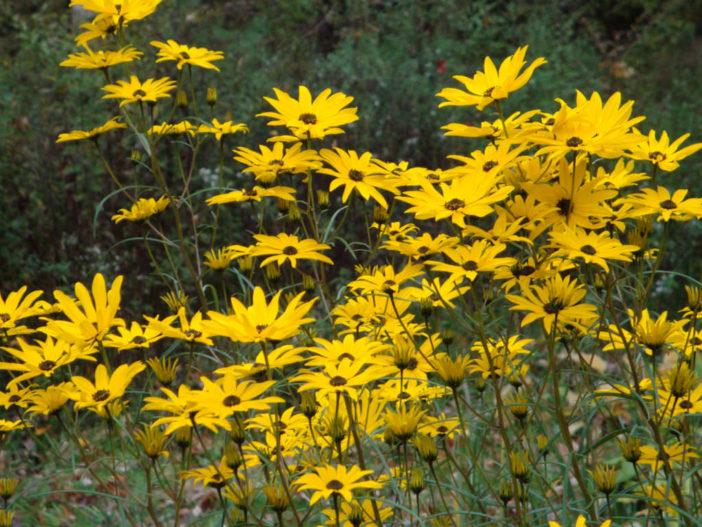
Common Names
Swamp Sunflower, Narrowleaf Sunflower
Synonyms
Helianthus angustifolius subsp. angustifolius, Helianthus angustifolius var. angustifolius, Coreopsis angustifolia, Discomela angustifolius
Scientific Classification
Family: Asteraceae
Subfamily: Asteroideae
Tribe: Heliantheae
Genus: Helianthus

Flower
Color: Yellow
Bloom Time: Early autumn
Description
Helianthus angustifolius is a perennial herb sometimes as much as 5 feet (1.5 m) tall. Leaves are long and narrow, up to 6 inches (15 cm) long. It is often cultivated for its bright, showy yellow flowers. One plant can produce 3 to 16 flower heads, each with 10 to 20 ray florets surrounding as least 75 disc florets.

How to Grow and Care
If you decide to add Sunflowers to your garden, there are a few things you will want to keep in mind.
First of all, they are called sunflowers for a reason. They need sun. Make sure that the location you choose for your Sunflowers gets full sun.
Second, you do not need to worry about soil too much. They are not picky about the conditions of the soil, but they are plants. They will do better in better soil.
Third, Sunflower seed shells do contain a substance that is toxic to grass. So, you will need to either harvest the Sunflower heads before the seeds begin to fall out or you will need to plant your Sunflowers in a location where you do not mind any nearby grass being killed.
Fourth, keep in mind the height of the Sunflower variety you have chosen. A giant, twelve foot variety will end up acting very much like a small tree and may shade the surrounding flowers.
Origin
Native to the south-central and eastern United States, found in all the coastal states from Texas to Long Island, and inland as far as Missouri.
Helianthus angustifolius L.

Common Names
Swamp Sunflower, Narrowleaf Sunflower
Synonyms
Helianthus angustifolius subsp. angustifolius, Helianthus angustifolius var. angustifolius, Coreopsis angustifolia, Discomela angustifolius
Scientific Classification
Family: Asteraceae
Subfamily: Asteroideae
Tribe: Heliantheae
Genus: Helianthus

Flower
Color: Yellow
Bloom Time: Early autumn
Description
Helianthus angustifolius is a perennial herb sometimes as much as 5 feet (1.5 m) tall. Leaves are long and narrow, up to 6 inches (15 cm) long. It is often cultivated for its bright, showy yellow flowers. One plant can produce 3 to 16 flower heads, each with 10 to 20 ray florets surrounding as least 75 disc florets.

How to Grow and Care
If you decide to add Sunflowers to your garden, there are a few things you will want to keep in mind.
First of all, they are called sunflowers for a reason. They need sun. Make sure that the location you choose for your Sunflowers gets full sun.
Second, you do not need to worry about soil too much. They are not picky about the conditions of the soil, but they are plants. They will do better in better soil.
Third, Sunflower seed shells do contain a substance that is toxic to grass. So, you will need to either harvest the Sunflower heads before the seeds begin to fall out or you will need to plant your Sunflowers in a location where you do not mind any nearby grass being killed.
Fourth, keep in mind the height of the Sunflower variety you have chosen. A giant, twelve foot variety will end up acting very much like a small tree and may shade the surrounding flowers.
Origin
Native to the south-central and eastern United States, found in all the coastal states from Texas to Long Island, and inland as far as Missouri.
0
0
文章
Dummer. ゛☀
2017年09月29日

Scientific Name
Helianthus angustifolius L.

Common Names
Swamp Sunflower, Narrowleaf Sunflower
Synonyms
Helianthus angustifolius subsp. angustifolius, Helianthus angustifolius var. angustifolius, Coreopsis angustifolia, Discomela angustifolius
Scientific Classification
Family: Asteraceae
Subfamily: Asteroideae
Tribe: Heliantheae
Genus: Helianthus

Flower
Color: Yellow
Bloom Time: Early autumn
Description
Helianthus angustifolius is a perennial herb sometimes as much as 5 feet (1.5 m) tall. Leaves are long and narrow, up to 6 inches (15 cm) long. It is often cultivated for its bright, showy yellow flowers. One plant can produce 3 to 16 flower heads, each with 10 to 20 ray florets surrounding as least 75 disc florets.

How to Grow and Care
If you decide to add Sunflowers to your garden, there are a few things you will want to keep in mind.
First of all, they are called sunflowers for a reason. They need sun. Make sure that the location you choose for your Sunflowers gets full sun.
Second, you do not need to worry about soil too much. They are not picky about the conditions of the soil, but they are plants. They will do better in better soil.
Third, Sunflower seed shells do contain a substance that is toxic to grass. So, you will need to either harvest the Sunflower heads before the seeds begin to fall out or you will need to plant your Sunflowers in a location where you do not mind any nearby grass being killed.
Fourth, keep in mind the height of the Sunflower variety you have chosen. A giant, twelve foot variety will end up acting very much like a small tree and may shade the surrounding flowers.
Origin
Native to the south-central and eastern United States, found in all the coastal states from Texas to Long Island, and inland as far as Missouri.
Helianthus angustifolius L.

Common Names
Swamp Sunflower, Narrowleaf Sunflower
Synonyms
Helianthus angustifolius subsp. angustifolius, Helianthus angustifolius var. angustifolius, Coreopsis angustifolia, Discomela angustifolius
Scientific Classification
Family: Asteraceae
Subfamily: Asteroideae
Tribe: Heliantheae
Genus: Helianthus

Flower
Color: Yellow
Bloom Time: Early autumn
Description
Helianthus angustifolius is a perennial herb sometimes as much as 5 feet (1.5 m) tall. Leaves are long and narrow, up to 6 inches (15 cm) long. It is often cultivated for its bright, showy yellow flowers. One plant can produce 3 to 16 flower heads, each with 10 to 20 ray florets surrounding as least 75 disc florets.

How to Grow and Care
If you decide to add Sunflowers to your garden, there are a few things you will want to keep in mind.
First of all, they are called sunflowers for a reason. They need sun. Make sure that the location you choose for your Sunflowers gets full sun.
Second, you do not need to worry about soil too much. They are not picky about the conditions of the soil, but they are plants. They will do better in better soil.
Third, Sunflower seed shells do contain a substance that is toxic to grass. So, you will need to either harvest the Sunflower heads before the seeds begin to fall out or you will need to plant your Sunflowers in a location where you do not mind any nearby grass being killed.
Fourth, keep in mind the height of the Sunflower variety you have chosen. A giant, twelve foot variety will end up acting very much like a small tree and may shade the surrounding flowers.
Origin
Native to the south-central and eastern United States, found in all the coastal states from Texas to Long Island, and inland as far as Missouri.
0
0
文章
Dummer. ゛☀
2017年09月18日

Othonna is a genus of more than 100 African plants in the Sunflower family (Asteraceae). These are evergreen or deciduous geophytes, dwarf succulents or shrubs concentrated in the Western Cape Province of South Africa and also in southern Namibia. A few species occur in summer rainfall parts of southern Africa. The genus is closely allied to Senecio and can be distinguished principally by details of the involucre.
The form or habit of Othonnas is very diverse. Leaf diversity is also notable in this genus. A few species possess highly succulent leaves (Othonna capensis, Othonna sedifolia) but most have bifacial leaves that are only slightly succulent. Size and shape is variable, with most species having leaves in the 0.4 to 4 inches (1 to 10 cm) long range.
The bright yellow (occasionally white or purple) flowers are the most distinguishing characteristic of the genus and the flowering times differ from different species. Some flower just before beginning their summer rest, and others flower after beginning growth in the fall.

Growing Conditions and General Care
Othonna plants have a variable range of habitats, some grow in a very hot, arid regions, but they avoid the intense desiccating rays of the north and west sun, growing between rocks in southern slopes. A few species, by contrary, grow in strong direct sunlight in arid situations that become very hot and dry as well as saturated for a few weeks during their growing period. All Othonnas grow in very open situations with plenty of free air circulation all around.
Othonnas fleshy leaves and daisy-like flowers make them excellent in a desert or rock garden (where hardy), or indoors as houseplants or greenhouse specimens.
Othonnas tend to be fairly hardy but some of them as Othonna cacalioides can be extremely difficult in cultivation if you do not give them the right conditions: space to develop radicular system, better to keep them in flat pots. In summer protect plants from direct sunlight. In growing season they like to be moist, fresh and plenty light. They don’t like temperatures below 50°F (10°C).
In the warmer months Othonnas go into their dormancy period, stop watering, place them in a shaded, cooler area, away from getting direct sunlight and with good air circulation, relatively dry. In the fall, sometime around early to mid October when nights cool down, the plants may start growing on their own, but a good soaking will help them to leaf out.
A typical succulent soil mix should be suitable for growing Othonnas but additional drainage material would be recommended.

Propagation
Start seed in spring at 64 to 70°F (18 to 21°C). Plants can also be propagated from basal or semi-ripe cuttings in late summer using bottom heat.
The form or habit of Othonnas is very diverse. Leaf diversity is also notable in this genus. A few species possess highly succulent leaves (Othonna capensis, Othonna sedifolia) but most have bifacial leaves that are only slightly succulent. Size and shape is variable, with most species having leaves in the 0.4 to 4 inches (1 to 10 cm) long range.
The bright yellow (occasionally white or purple) flowers are the most distinguishing characteristic of the genus and the flowering times differ from different species. Some flower just before beginning their summer rest, and others flower after beginning growth in the fall.

Growing Conditions and General Care
Othonna plants have a variable range of habitats, some grow in a very hot, arid regions, but they avoid the intense desiccating rays of the north and west sun, growing between rocks in southern slopes. A few species, by contrary, grow in strong direct sunlight in arid situations that become very hot and dry as well as saturated for a few weeks during their growing period. All Othonnas grow in very open situations with plenty of free air circulation all around.
Othonnas fleshy leaves and daisy-like flowers make them excellent in a desert or rock garden (where hardy), or indoors as houseplants or greenhouse specimens.
Othonnas tend to be fairly hardy but some of them as Othonna cacalioides can be extremely difficult in cultivation if you do not give them the right conditions: space to develop radicular system, better to keep them in flat pots. In summer protect plants from direct sunlight. In growing season they like to be moist, fresh and plenty light. They don’t like temperatures below 50°F (10°C).
In the warmer months Othonnas go into their dormancy period, stop watering, place them in a shaded, cooler area, away from getting direct sunlight and with good air circulation, relatively dry. In the fall, sometime around early to mid October when nights cool down, the plants may start growing on their own, but a good soaking will help them to leaf out.
A typical succulent soil mix should be suitable for growing Othonnas but additional drainage material would be recommended.

Propagation
Start seed in spring at 64 to 70°F (18 to 21°C). Plants can also be propagated from basal or semi-ripe cuttings in late summer using bottom heat.
0
0
文章
Dummer. ゛☀
2017年08月26日

Yacon (Smallanthus sonchifolius) is a fascinating plant. Above, it looks something like a sunflower. Below, something like a sweet potato. Its taste is most frequently described as very fresh, a cross between an apple and a watermelon. It is also known as sweet-root, Peruvian ground apple, Bolivian sunroot, and pear of the earth. So what is a yacon plant?
Yacon Root Info
The yacon is native to the Andes, in present day Colombia, Bolivia, Ecuador, and Peru. It’s gaining worldwide popularity, however, in part because of its unusual source of sweetness. Unlike most tubers, which get their sweetness from glucose, yacon root derives its sweetness from inulin, which the human body can’t process. This means you can taste the sweetness of yacon root, but your body won’t metabolize it. This is good news for people looking to lose weight, and especially good news for diabetics. The yacon plant can grow to 6.5 feet (2 meters) in height, topped in small, daisy-like yellow flowers. Underground, there are two distinct elements. On top is a collection of reddish rhizomes that looks a bit like a ginger root. Below that are the brown, edible tubers, very similar in appearance to a sweet potato.
How to Grow Yacon Plants
Yacon does not propagate by seed, but by rhizome: that clump of red just below the soil. If you are beginning with unsprouted rhizomes, keep them in a dark place, slightly covered in damp sand. Once they’ve sprouted, plant them at a depth of 1 inch (3cm) in well-worked, composted soil, and cover them with mulch. The plants are slow to grow, so if you live in an area that experiences frost, start them indoors in very early spring. Their growth is unaffected by day length, so if you live in a frostless area, they can be planted at any time of the year.
Yacon plant care is easy, though the plants get very tall and may need to be staked. After six to seven months, the plants will naturally start to brown and die. This is the time to harvest. Dig around carefully with your hands so as not to damage the roots. Set out the tubers to dry — they can sit in the sun for as much as two weeks to heighten sweetness. Then, store them in a cool, dry, ventilated place. Set aside the rhizomes for next year’s planting.

Yacon Root Info
The yacon is native to the Andes, in present day Colombia, Bolivia, Ecuador, and Peru. It’s gaining worldwide popularity, however, in part because of its unusual source of sweetness. Unlike most tubers, which get their sweetness from glucose, yacon root derives its sweetness from inulin, which the human body can’t process. This means you can taste the sweetness of yacon root, but your body won’t metabolize it. This is good news for people looking to lose weight, and especially good news for diabetics. The yacon plant can grow to 6.5 feet (2 meters) in height, topped in small, daisy-like yellow flowers. Underground, there are two distinct elements. On top is a collection of reddish rhizomes that looks a bit like a ginger root. Below that are the brown, edible tubers, very similar in appearance to a sweet potato.

How to Grow Yacon Plants
Yacon does not propagate by seed, but by rhizome: that clump of red just below the soil. If you are beginning with unsprouted rhizomes, keep them in a dark place, slightly covered in damp sand. Once they’ve sprouted, plant them at a depth of 1 inch (3cm) in well-worked, composted soil, and cover them with mulch. The plants are slow to grow, so if you live in an area that experiences frost, start them indoors in very early spring. Their growth is unaffected by day length, so if you live in a frostless area, they can be planted at any time of the year.

Yacon plant care is easy, though the plants get very tall and may need to be staked. After six to seven months, the plants will naturally start to brown and die. This is the time to harvest. Dig around carefully with your hands so as not to damage the roots. Set out the tubers to dry — they can sit in the sun for as much as two weeks to heighten sweetness. Then, store them in a cool, dry, ventilated place. Set aside the rhizomes for next year’s planting.
0
0
文章
Dummer. ゛☀
2017年08月26日

Stevia is an attractive herbaceous plant that belongs to the sunflower family. Native to South America, stevia is often known as “sweetleaf” for its intensely sweet leaves, used to flavor teas and other beverages for centuries. In recent years, stevia has become popular in the United States, valued for its ability to sweeten food naturally without raising blood sugar or adding calories. Growing stevia isn’t difficult, but overwintering stevia plants can present challenges, especially in northern climates.
Stevia Winter Plant Care
Growing stevia or stevia planting in winter isn’t an option for gardeners in cool climates. However, if you live in USDA plant hardiness zone 8, stevia usually survives the winter with a thick layer of mulch to protect the roots. If you live in a warm climate (zone 9 or above), growing stevia plants in winter is not a problem and the plants require no protection.
Can Stevia Be Grown Over Winter?
Overwintering stevia plants indoors is necessary in colder regions. If you live in a cooler climate north of zone 9, bring stevia indoors before the first frost in autumn. Trim the plant to a height of about 6 inches, then move it to a pot with a drainage hole, using a good quality commercial potting mix. You may be able to grow stevia on a sunny windowsill, but without adequate light, the plant is likely to become spindly and less productive. Most plants perform better under fluorescent lights. Stevia prefers room temperatures above 70 F. (21 C.). Snip the leaves for use as needed.
Move the plant back outdoors when you’re sure all danger of frost has passed in spring. If you’ve never grown stevia, it is usually available at greenhouses or nurseries specializing in herbal plants. You can also plant seeds, but germination tends to be slow, difficult and undependable. Additionally, leaves grown from seed may not be as sweet. Stevia plants often decline after the second year, but it’s easy to propagate new plants from healthy, mature stevia.

Stevia Winter Plant Care
Growing stevia or stevia planting in winter isn’t an option for gardeners in cool climates. However, if you live in USDA plant hardiness zone 8, stevia usually survives the winter with a thick layer of mulch to protect the roots. If you live in a warm climate (zone 9 or above), growing stevia plants in winter is not a problem and the plants require no protection.

Can Stevia Be Grown Over Winter?
Overwintering stevia plants indoors is necessary in colder regions. If you live in a cooler climate north of zone 9, bring stevia indoors before the first frost in autumn. Trim the plant to a height of about 6 inches, then move it to a pot with a drainage hole, using a good quality commercial potting mix. You may be able to grow stevia on a sunny windowsill, but without adequate light, the plant is likely to become spindly and less productive. Most plants perform better under fluorescent lights. Stevia prefers room temperatures above 70 F. (21 C.). Snip the leaves for use as needed.

Move the plant back outdoors when you’re sure all danger of frost has passed in spring. If you’ve never grown stevia, it is usually available at greenhouses or nurseries specializing in herbal plants. You can also plant seeds, but germination tends to be slow, difficult and undependable. Additionally, leaves grown from seed may not be as sweet. Stevia plants often decline after the second year, but it’s easy to propagate new plants from healthy, mature stevia.
0
0
文章
Dummer. ゛☀
2017年08月26日

Santolina herb plants were introduced to the United States from the Mediterranean in 1952. Today, they are recognized as a naturalized plant in many areas of California. Also known as lavender cotton, Santolina herb plants are members of the sunflower/aster family (Asteraceae). So what is Santolina and how do you use Santolina in the garden landscape?
What is Santolina?
An herbaceous perennial suited to hot, dry summer and full sun, Santolina (S. chamaecyperissus) is indigent to areas of sandy, rocky infertile soils but will also do well in garden loam and even clay, provided it is well amended and well-drained.
These evergreen shrubs have either silvery grey or green leaves reminiscent of conifers. Santolina has a mounded, round and dense habit reaching only 2 feet high and wide with vibrant yellow ½-inch flowers perched on stems above the foliage, which are notably attractive in dried flower arrangements and wreaths. The silver foliage makes a nice contrast to other green tones of the garden and persists through the winter. It is a prominent specimen for xeriscapes and mixes well with other Mediterranean herbs such as lavender, thyme, sage, oregano, and rosemary.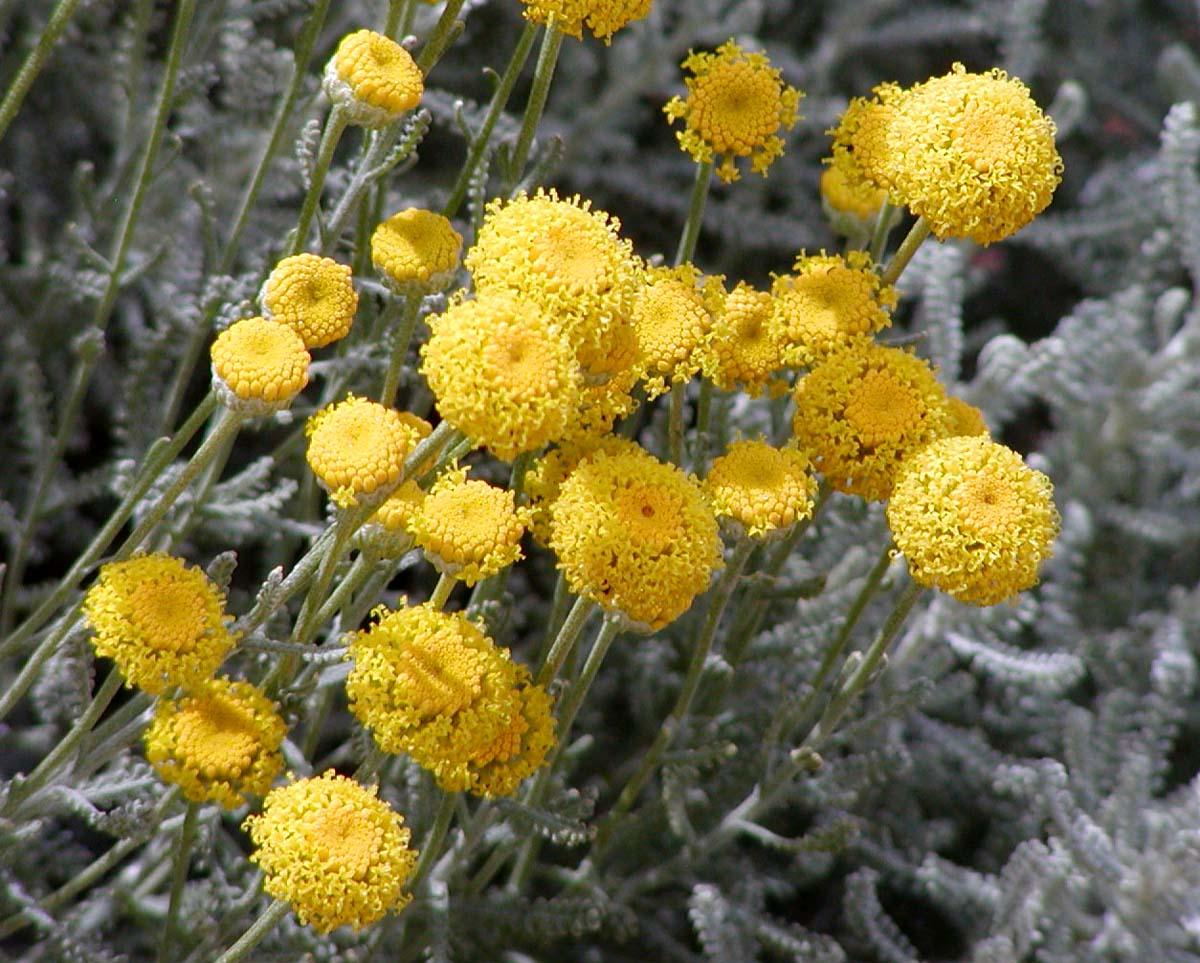
Lovely in a mixed perennial border along with rockroses, Artemisia and buckwheat, growing Santolina has a virtual plethora of uses in the home landscape. Growing Santolina can even be trained into a low hedge. Give the plants plenty of room to spread or allow them to take over and create a massed ground cover. Santolina herb plants also have a fairly pungent aroma akin to camphor and resin mixed when the foliage is bruised. Perhaps this is why deer don’t seem to have a yen for it and leave it alone.
Santolina Plant Care
Plant your Santolina herb in areas of full sun through USDA zone 6 in almost any type of soil. Drought tolerant, Santolina herb requires minimal to moderate irrigation once established. Overwatering will likely kill the plant. Wet, humid weather will foster fungal development. Prune Santolina back drastically in the late winter or spring to keep it from splitting or dying out in the center of the plant. However, if this happens, other Santolina plant care indicates ease of propagation.
Simply take 3-4 inch cuttings in the fall, pot them and provide heat, then plant in the garden in summer. Or, seed can be sown under a cold frame in fall or spring. The herb will also begin to grow roots when a branch touches the soil (called layering), thereby creating a new Santolina. Besides over watering, the downfall of Santolina is its short life; about every five years or so (as lavender) the plant needs to be replaced. Luckily it is easy to propagate. Plants can also be divided in the spring or fall. Santolina herb plant is fairly pest and disease resistant, drought tolerant and deer resistant, and easy to propagate. Santolina herb plant is a must have specimen for the water-efficient garden or an excellent replacement when eliminating a lawn entirely.

What is Santolina?
An herbaceous perennial suited to hot, dry summer and full sun, Santolina (S. chamaecyperissus) is indigent to areas of sandy, rocky infertile soils but will also do well in garden loam and even clay, provided it is well amended and well-drained.
These evergreen shrubs have either silvery grey or green leaves reminiscent of conifers. Santolina has a mounded, round and dense habit reaching only 2 feet high and wide with vibrant yellow ½-inch flowers perched on stems above the foliage, which are notably attractive in dried flower arrangements and wreaths. The silver foliage makes a nice contrast to other green tones of the garden and persists through the winter. It is a prominent specimen for xeriscapes and mixes well with other Mediterranean herbs such as lavender, thyme, sage, oregano, and rosemary.

Lovely in a mixed perennial border along with rockroses, Artemisia and buckwheat, growing Santolina has a virtual plethora of uses in the home landscape. Growing Santolina can even be trained into a low hedge. Give the plants plenty of room to spread or allow them to take over and create a massed ground cover. Santolina herb plants also have a fairly pungent aroma akin to camphor and resin mixed when the foliage is bruised. Perhaps this is why deer don’t seem to have a yen for it and leave it alone.
Santolina Plant Care
Plant your Santolina herb in areas of full sun through USDA zone 6 in almost any type of soil. Drought tolerant, Santolina herb requires minimal to moderate irrigation once established. Overwatering will likely kill the plant. Wet, humid weather will foster fungal development. Prune Santolina back drastically in the late winter or spring to keep it from splitting or dying out in the center of the plant. However, if this happens, other Santolina plant care indicates ease of propagation.

Simply take 3-4 inch cuttings in the fall, pot them and provide heat, then plant in the garden in summer. Or, seed can be sown under a cold frame in fall or spring. The herb will also begin to grow roots when a branch touches the soil (called layering), thereby creating a new Santolina. Besides over watering, the downfall of Santolina is its short life; about every five years or so (as lavender) the plant needs to be replaced. Luckily it is easy to propagate. Plants can also be divided in the spring or fall. Santolina herb plant is fairly pest and disease resistant, drought tolerant and deer resistant, and easy to propagate. Santolina herb plant is a must have specimen for the water-efficient garden or an excellent replacement when eliminating a lawn entirely.
1
0
文章
Dummer. ゛☀
2017年08月22日

A member of the sunflower family, arnica (Arnica spp.) is a perennial herb that produces yellow-orange, daisy-like blooms in late spring and early summer. Also known as mountain tobacco, leopard’s bane and wolfbane, arnica is highly valued for its herbal qualities. However, before you decide to grow arnica or use the herb medicinally, there are a number of things you should know. 
Arnica Herb Uses
What is arnica herb for? Arnica has been used medicinally for hundreds of years. Today, the roots and flowers are used in topical treatments such salves, liniments, ointments, tinctures and creams that soothe tired muscles, relieve bruises and sprains, ease the itch of insect bites, soothe burns and minor wounds, promote hair growth and reduce inflammation. Although the herb is usually applied topically, homeopathic remedies with highly diluted amounts of the herb are available in pill form. Arnica is generally safe when used topically, although products containing arnica should never be used on broken skin. However, arnica should never be taken internally except when the doses are small and extremely diluted (and with the guidance of a professional). The plant contains a number of toxins that can cause a variety of potentially dangerous results, including dizziness, vomiting, internal bleeding and heart irregularities. Ingesting large amounts can be deadly.
Arnica Growing Conditions
Arnica is a hardy plant suitable for growing in USDA plant hardiness zones 4 through 9. The plant tolerates nearly any well-drained soil, but generally prefers sandy, slightly alkaline soil. Full sunlight is best, although the arnica benefits from a bit of afternoon shade in hot climates.
How to Grow Arnica
Planting arnica isn’t difficult. Just sprinkle the seeds lightly on prepared soil in late summer, then cover them lightly with sand or fine soil. Keep the soil slightly moist until the seeds germinate. Be patient; seeds usually sprout in about a month, but germination can take much longer. Thin the seedlings to allow about 12 inches between each plant. You can also start arnica seeds indoors. Plant the seeds in pots and keep them in bright, indirect sunlight where temperatures are maintained at approximately 55 F. (13 C.) For best results, grow the plants indoors for several months before moving them to a permanent outdoor location after all danger has passed in spring. If you have access to established plants, you can propagate arnica by cuttings or divisions in spring.
Arnica Plant Care
Established arnica plants require very little attention. The primary consideration is regular irrigation, as arnica is not a drought-tolerant plant. Water often enough to keep the soil lightly moist; don’t allow the soil to become bone dry or soggy. As a general rule, water when the top of the soil feels slightly dry. Remove wilted flowers to encourage continued blooming throughout the season. Disclaimer: The contents of this article is for educational and gardening purposes only. Before using ANY herb or plant for medicinal purposes, please consult a physician or a medical herbalist for advice.

Arnica Herb Uses
What is arnica herb for? Arnica has been used medicinally for hundreds of years. Today, the roots and flowers are used in topical treatments such salves, liniments, ointments, tinctures and creams that soothe tired muscles, relieve bruises and sprains, ease the itch of insect bites, soothe burns and minor wounds, promote hair growth and reduce inflammation. Although the herb is usually applied topically, homeopathic remedies with highly diluted amounts of the herb are available in pill form. Arnica is generally safe when used topically, although products containing arnica should never be used on broken skin. However, arnica should never be taken internally except when the doses are small and extremely diluted (and with the guidance of a professional). The plant contains a number of toxins that can cause a variety of potentially dangerous results, including dizziness, vomiting, internal bleeding and heart irregularities. Ingesting large amounts can be deadly.

Arnica Growing Conditions
Arnica is a hardy plant suitable for growing in USDA plant hardiness zones 4 through 9. The plant tolerates nearly any well-drained soil, but generally prefers sandy, slightly alkaline soil. Full sunlight is best, although the arnica benefits from a bit of afternoon shade in hot climates.
How to Grow Arnica
Planting arnica isn’t difficult. Just sprinkle the seeds lightly on prepared soil in late summer, then cover them lightly with sand or fine soil. Keep the soil slightly moist until the seeds germinate. Be patient; seeds usually sprout in about a month, but germination can take much longer. Thin the seedlings to allow about 12 inches between each plant. You can also start arnica seeds indoors. Plant the seeds in pots and keep them in bright, indirect sunlight where temperatures are maintained at approximately 55 F. (13 C.) For best results, grow the plants indoors for several months before moving them to a permanent outdoor location after all danger has passed in spring. If you have access to established plants, you can propagate arnica by cuttings or divisions in spring.

Arnica Plant Care
Established arnica plants require very little attention. The primary consideration is regular irrigation, as arnica is not a drought-tolerant plant. Water often enough to keep the soil lightly moist; don’t allow the soil to become bone dry or soggy. As a general rule, water when the top of the soil feels slightly dry. Remove wilted flowers to encourage continued blooming throughout the season. Disclaimer: The contents of this article is for educational and gardening purposes only. Before using ANY herb or plant for medicinal purposes, please consult a physician or a medical herbalist for advice.
0
0
文章
Dummer. ゛☀
2017年08月15日

This lovely sunflower forms largeattractive clumps up to a metre in height. The easiest way to distinguish Arrowleaf Balsamroot from other sunflowers is by the silvery-green arrow-head-shaped leaves.

Distribution
The range of the plant extends from British Columbia and south to Colorado and central California. It is one of many sunflowers found in the Rocky Mountains.

Habitat and Blooming Times
Arrowleaf Balsamroot grows on well-drained soil in open woodland sites exposed to plenty of sunshine. It blooms from late May to July and grows
Uses
American Indians used the seeds to make a kind of flour called pinole.

Etymology
Balsamorhiza, the genus name, means 'balsam root'. The specific epithet sagittata means 'arrow shaped' - a reference to the leaves of this plant, which are shaped like arrowheads.

Distribution
The range of the plant extends from British Columbia and south to Colorado and central California. It is one of many sunflowers found in the Rocky Mountains.

Habitat and Blooming Times
Arrowleaf Balsamroot grows on well-drained soil in open woodland sites exposed to plenty of sunshine. It blooms from late May to July and grows
Uses
American Indians used the seeds to make a kind of flour called pinole.

Etymology
Balsamorhiza, the genus name, means 'balsam root'. The specific epithet sagittata means 'arrow shaped' - a reference to the leaves of this plant, which are shaped like arrowheads.
0
0



